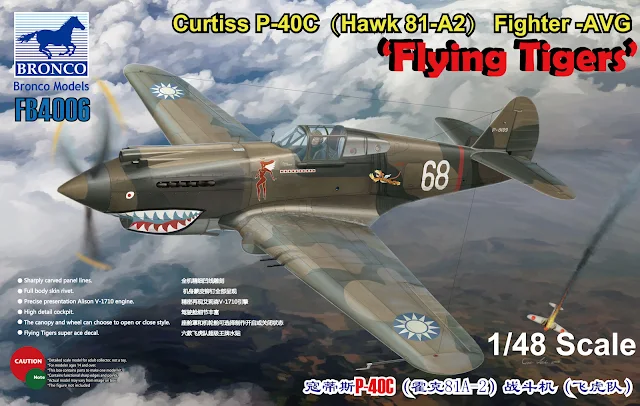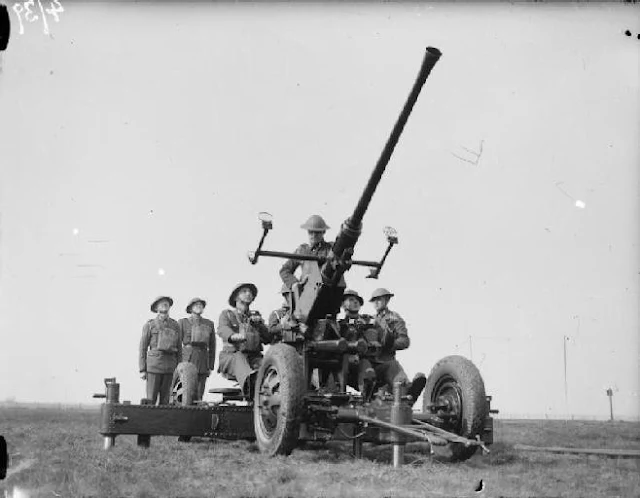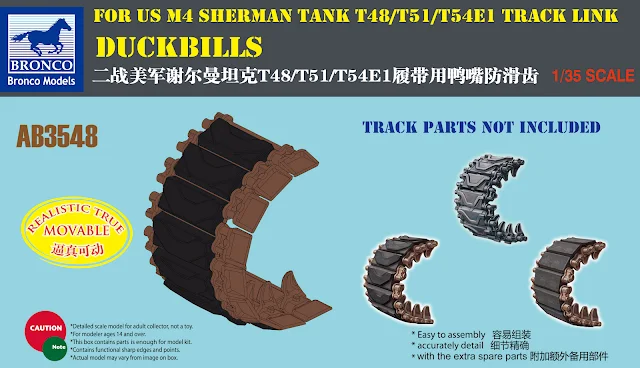Bronco Models
bring us five new kits this month, from a little known US pop gun to a well-known
British cousin, a one of a kind Soviet tank to a Tiger that flies – and don’t
forget a tank with duckbills! See what
we mean with Bronco’s new April items…
Bronco Models NEW Products
for April 2016
Curtiss P-40C Fighter (Hawk
81-A2) - AVG ’Flying Tigers’
1/48th scale
#FB4006
The P-40 was the workhorse of the Allied aerial arsenal
right through 1944. It may not have been as "hot" as later designs,
but it was a sound design, based on the earlier P-36, mated to the Allison
V-1710 engine, that Curtis was able to produce in large numbers. As Clair
Chennault found out in China, the P-40 was heavier, faster, and sturdier than
Japanese fighters, and it out-gunned them as well. Properly handled and below
15,000 feet, it was a lethal
Colonel (later General Claire Lee Chennault) had been in
China since the mid-Thirties. An outspoken advocate of "pursuit" (as
fighter planes were called then), in an Army Air Force dominated by strategic
bomber theorists, he alienated many of his superiors. But in China, equipped
with P-40's, he developed the basic fighter tactics that American pilots would
use throughout the war.
The Japanese planes used over China were much more manoeuvrable
than his Warhawks, whose advantages were speed in a dive, superior firepower,
and better ability to absorb battle damage. Chennault worked out and documented
the appropriate tactics that capitalized on the relative strengths of the
American fighters: intercept, make a diving pass, avoid dogfighting, and dive
away when in trouble. This remained the fundamental U.S. fighter doctrine
throughout the Pacific War.
The feature set of
this kit…
The decal choices included - interesting not the box art model is not shown amongst these but there are six included so we thing that it's in there...
WWII Russian Heavy Tank
KV-122
1/35th scale
#CB35122
On June 22nd in 1941 Nazi Germany launched a
blitzkrieg attack on the Soviet Russian, which started Russo-German War (known
as the Great Patriotic War) during World War II. Right up until the Battle of
Stalingrad the Russian army was retreating and in disarray. But Stalingrad became
the turning point of World War II, with a German surrender, and the summer of
1943 the battle of Kursk gave the Russians the offensive momentum to turn to a
more strategic counteroffensive plan.
As this time the Soviet Union urgently needed a more
powerful tank to withstand with Nazi’s division, so the Russian Central Design
Bureau immediately adopted the KV-1S chassis, with the addition of new turret
which became the KV-85 heavy tank. As soon as possible in order to deploy more
and heavier tanks to the front, Joseph Yakovlevich Kotin led the Central Design
Bureau for KV-85 to get improved firepower, and after some testing, the 122mm/
D-25T gun was selected.
This became the prototype heavy tank KV-122 (only one was
made), and this tank was not put into production, because the Soviets had
already developed other heavy tanks equipped with the 122mm like the successful
IS-2 heavy tank.
The feature set of
this kit…
OQF Bofors 40mm
Anti-Aircraft Gun Mk. I/III (British Army) & Gun Crew Set
1/35th scale
#CB35111SP
The British Army purchased several Polish-built 40mm Bofors
guns in 1937, designating them the Ordnance Quick Fire (OQF) 40mm Mk.I.
Suitably impressed with this weapon, a production licence was acquired from
Bofors and the gun was produced at Royal Ordnance factories in Britain. The gun
was changed from metric to Imperial measurements, and several design
improvements were made to facilitate mass production. This British built gun
was designated the OQF 40mm Mk.III, and became the standard light anti-aircraft
gun of the British Army. It was designed to operate with the Kerrison Predictor,
a mechanical analogue computer which automatically laid the gun after simple
calculations had been dialled in.
A back-up sight ring and post, known as the
"Pancake", was also provided. This was later used as the primary
sight as the Kerrison Predictor proved too complicated to use in many
situations and required constant fuel supplies for its electrical generator. In
1943 the Pancake sights were replaced by the Stiffkey sight which offered
lead-correction, the sight was operated by an additional crew member. British
guns were fitted with an armour shield to protect the crew from shell splinters
and small arms fire. In British service the Bofors was usually towed by a 6x4
Morris tractor, later in the war the gun was mounted on a 4x4 Morris truck.
The feature set of
this kit…
WWII US army M3A1 37mm
anti-tank gun
1/35th scale
#CB35147
The US 37mm M3 anti-tank gun was the first weapon of this
type to be manufactured in the United States. But as the US had no experience
building such weapons. Two German 3.7cm PaK 35/36 guns were acquired for
evaluation in January 1937. During 1938 several guns and carriages were
designed and tested, with the T10 gun with T5 carriage determined the best.
These were redesignated as the 37mm M3 anti-tank gun and the first guns were
delivered in early 1940. It was the standard anti-tank gun of the US Infantry
Divisions and USMC. It was usually towed by a 4x4 1/4-ton Jeep or larger 3/4-ton
Dodge truck.
The 37mm M3A1 had several modifications including provision
for a muzzle brake, and entered service in March 1942. This was the main
production model with over 10,000 built. This weapon served in Europe until
mid-1943, when it was replaced by a copy of the British 6 Pounder. But in the
Pacific the M3A1 served until the end of the war. The M3A1 firing M51 APC
ammunition could penetrate 60mm of vertical armour plate at 1000 meters.
The feature set of
this kit…
“Duckbills” for US M4 Sherman Tank
T48/T51/T54E1 Track Links
1/35th scale
#AB3548
These wider tracks were used by the Shermans and others like
the T48/T51/T54E1 to traverse muddy and snowy conditions. Often used in
Northern Europe these reduced ground pressure of these vehicles in off road
conditions. The Sherman tank’s high ground pressure, restricted its ability to
cross boggy ground unless fitted with duck bill-shaped extensions to the
tracks. The downside was that the tank had to keep its speed down to avoid
breaking them off.
Sherman tank with
duckbill tracks.
All of these kits
will be available in April, check out the Bronco Models website for
more information on their distributors nearer to you.






















